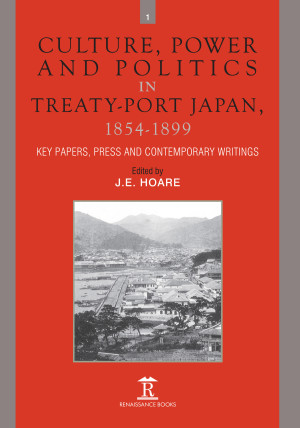VOLUME 1: HISTORICAL PERSPECTIVES
Acknowledgements
Map of Japan’s open ports and cities
List of Plates
Introduction and Restrospective
1. Convention between Great Britain and Japan 1854
2. Treaty of Amity and Commerce, 1858
3. Treaty of Commerce and Navigation between Great Britain and Japan,
1894
4. Treaty of Friendship, Commerce and Navigation between the
Austro-Hungarian Monarchy and Empire of Japan, 1869
5. Land Regulations, etc.
6. That ‘Naughty Yankee Boy’: Edward H. House and Meiji Japan’s
Struggle for Equality
7. Early Western Architecture in Japan’
8. Japan and the Western Powers
9. The Bund: Littoral Space of Empire in the Treaty Ports
of East Asia
10. Western Entrepreneurs and the Opening of Japanese Ports
11. The First Women Religious in Japan: Mother Saint Mathilde
Raclot and the French Connection
12. Gentlemanly Capitalism and the Club: Expatriate Social Networks
in Meiji Kobe
13. Imposed Efficiency of the Treaty Ports: Japanese Industrialization
and Western Imperialist Institutions
14. The Revision of Japan’s Early Commercial Treaties
15. Lafcadio Hearn on Foreign Settlements
16. An Englishman’s Right to Hunt: Territorial Sovereignty and
Extraterritorial Privilege in Japan
17. ‘Residential Rhymes: Sympathetically Dedicated to
Foreigners in Japan’
18. Parkes (Sir Harry)
9. Treaties with Foreign Powers
20. Kokusai Kekkon and Meiji Japan
21. What the Passport Requires
22. All Things to All Men
23. Two Remarkable Australians of Old Yokohama,
24. Tourist Guide
25. Japan Reverses the Unequal Treaties: The Anglo-Japanese
Commercial Treaty of 1894
26. Extraterritoriality in Japan, 1858–1899
27. The Chinese in the Japanese Treaty Ports, 1858–1899:
The Unknown Majority
28. The Stage Is the World: Theatrical and Musical Entertainment
in Three Japanese Treaty Ports
29. ‘Shades of the Past’: The Introduction of Baseball into Japan
30. ‘Competitors with the English sporting men’. Civilization,
Enlightenment and Horse Racing: Anglo-Japanese Relations, 1860–2010.
VOLUME 2 : THE TREATY PORTS
Plate section faces page 258
HAKODATE
31. Dr. John Batchelor, British Scholar and Friend of the Natives of
Hokkaido
32. Thomas Wright Blakiston: The Blakiston Line
33. Hakodadi
34. The Murder of Ludwig Haber
35. Hokkaido (Ezo): Some Impressions of British Visitors (1854–1873),
36. Departure from Japan
37. Mr. Enslie’s Grievances: The Consul, the Ainu and the Bones
KOBE
38. History of Kobe
39. Mr. Van Valkenburgh to Mr. Seward
40. A Swede in Meiji Japan: Herman Trotzig (1832–1919)
NAGASAKI
41. Nagasaki: The Treaty Ports of China and Japan
42. British Influence in the Foreign Settlement at Nagasaki
43. City of Nagasaki: Chinese in Nagasaki, 1859–60
44. Italian Influence in the ‘Naples of Japan’, 1859–1941
45. Thomas Glover of Nagasaki
YOKOHAMA
46. ‘Yokuhama’, in Ten Weeks in Japan, 1861,
47. Mr. Van Valkenburgh, Letter to Mr. Seward
48. The Vocabulary of the Japanese Ports Lingo
49. Treaty Port Attitudes.
50. Yokohama
51. The First Six Months of the Asiatic Society of Japan,
52. Yokohama before the Catastrophe
53. The Gankiro Teahouse and No. 9 in Old Yokohama
54. Life in a Buddhist Temple at Kanagawa
55. The Story of Yokohama Union Church, 1872–1923
56. Yokohama in 1872: A rambling account of the community in which
the Asiatic Society of Japan was founded.
57. Revised and Enlarged Edition of Exercises in the Yokohama Dialect,
58. British Consuls and British Merchants,
59. Yokohama Ballads, c.1890, 1–8 342
Bibliography

